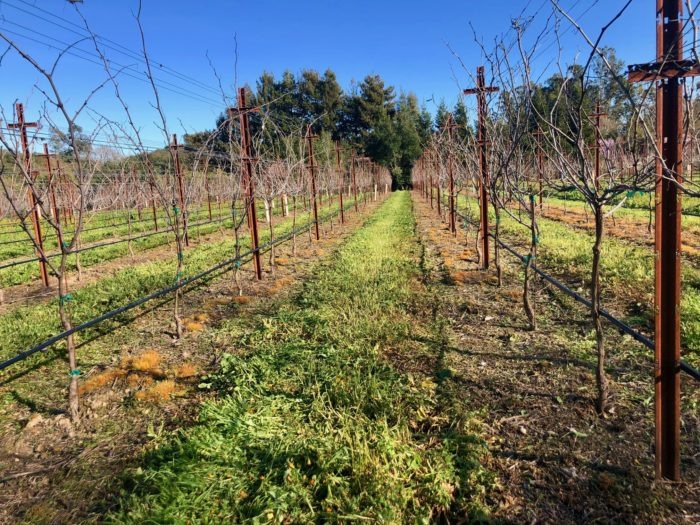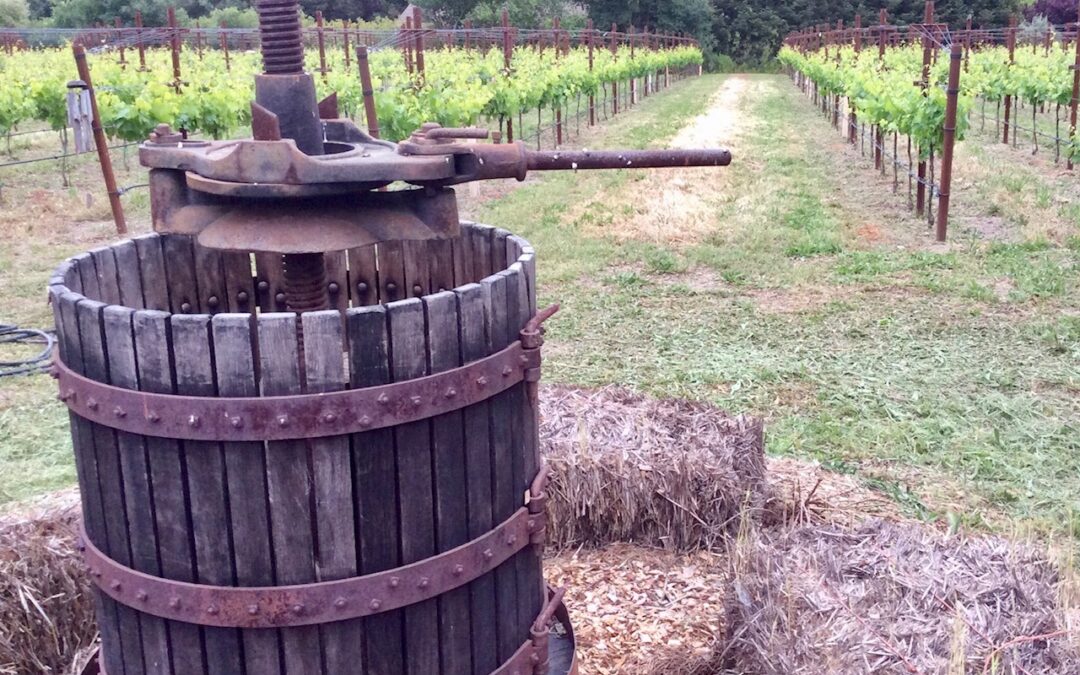
May 19, 2019 | Wine
Update – May 29th, 2019 – Republishing this blog post with more current information – the rain is over, the sun has arrived, and the vineyards have dried out enough to rush labor and tractors into the vineyards. As of today, it looks like we avoided most of the shatter risk, but traded that in for the risk of mold and mildew pressure All of our vineyards are managed organically. In the past few days we’ve sprayed a expensive “cocktail” of Serenade (Bacillus subtilis strain QST 713, a beneficial bacterium), BioLink-Fe-Mn-Zn and B (micro-nutrients Iron, Magnesium, Zinc, and Boron), BioAtlantis Super-50 (designed to reduce abiotic stress by priming the plant in advance of stress), and Sulfur (fungicide). More to follow as the season advances…
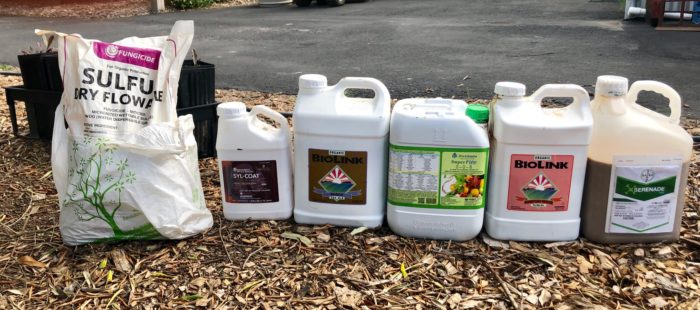
Listen to Sonoma Radio KSVY on May 22nd – start at time mark 26.15 to 38.00 minutes:
http://ksvy.org/showarchive/public/KSVY_2019-05-22__09_00_15.mp3
May 19th, 2019 – I just sent this letter off to all of my vineyard and wine clients. Thought our blog readers would find it interesting:
Dear Clients –
2019 is, so far, a vintage like no other.
After the terrific harvest right before the fires of 2017, and the huge ripe crop of 2018, the 2019 vintage is shaping up to be one of the most challenging in my 25-year career.
Why? In a word – rain!
We are all really very grateful for every drop after a decade of drought. But even as I write this on the afternoon of May 19th, very late in the growing season, the rain is falling like it’s still February.
2” – 3” in the last 48 hours.
And why exactly is this late season rain a potential problem? 4 reasons…
- Grape shatter – shatter is a word that describes what happens when grape flowers remain un-pollinated. Late in the season this shows up as grape bunches with missing berries in the bunches (see image 1). Like olives and corn, grapes are pollinated by air and breeze. Sun and gentle light breezes are perfect. Hard rain and cold and gusty wind is not. And this is what we have, in excess, right now. Not much can be done about it. It’s a force of nature. It might help to open up the canopy, remove shoots, remove leaves, get the air moving. But this is time consuming and therefore expensive.
- Suckers – with this excessive rain, the plants are responding by pushing excessive shoots, including many suckers low on the trunk. Suckers are fruitless and drain vines of energy later in the season and must be removed soon. And usually by hand. Again, time consuming and therefore expensive. (see image 2)
- Canopy expansion – with the tremendous late-spring rains come tremendous early season shoot growth. The canopies are growing extremely fast, pushing large quantities of green material. When the sun comes out, hot humid air will be trapped in the dense canopies inviting major mold and mildew pressure. How do we alleviate this threat? With judicious shoot thinning and de-leafing, and additional spray cycles. But we can’t apply the excess spray cycles while it’s raining. The tractors can’t operate in mud. And rain following an application just washes away the application. And again, extra manpower and extra applications are time consuming and therefore expensive. (see image 3)
- Weeds – obviously, with all this extra rain comes tremendous weed growth on the vineyard floor. It is not only unsightly, it competes with the grape vines. And it is depressing for vineyard managers who worked so hard in April to make the vineyard look so good! Further, for those that are fully organic (almost all of you), we can’t turn to Round-Up (a very inexpensive and effective solution) and instead must rely on hand labor. (see image 4)
The obvious question arises – what to do?
Luckily, we have excellent options. We have the knowledge, the skills, the tools and equipment, and the right people in place.
For those of you with ‘unlimited budgets’ it’s all still a threat, but one we can attack and manage.
Projects with tight budgets, and/or with budgets are already stretched thin, that is a harder challenges. Ideally, we would perform extra weeding and mowing, extra spraying, and put some labor hours into suckering and canopy thinning. And even after those steps, in the Fall the crop may still weigh in well under nominal if the shatter is severe. Only time will tell.
Every micro-climate is unique. This could all be a ‘sky is falling’ fake out.
It is entirely possible that at your specific site, the rain will stop and the sun will shine and the flowers will open and pollinate.
I ask you each to think about these challenges. And consider what steps you want us to take.
From here, I’ll take the conversation private with each of you.
Thank you.
– Ken
Ken Wornick
Hydeout Sonoma LLC – vineyard development, winemaking, and brand consulting
Example of grape shatter
example of excessive grapevine suckers
un-thinned vs thinned canopy (and the labor involved in thinning)
Vineyard with marginal weed control (and again too many suckers)
Vineyard with weed control under the vines with conventional Round-Up (note ‘burned’ strips under vines)
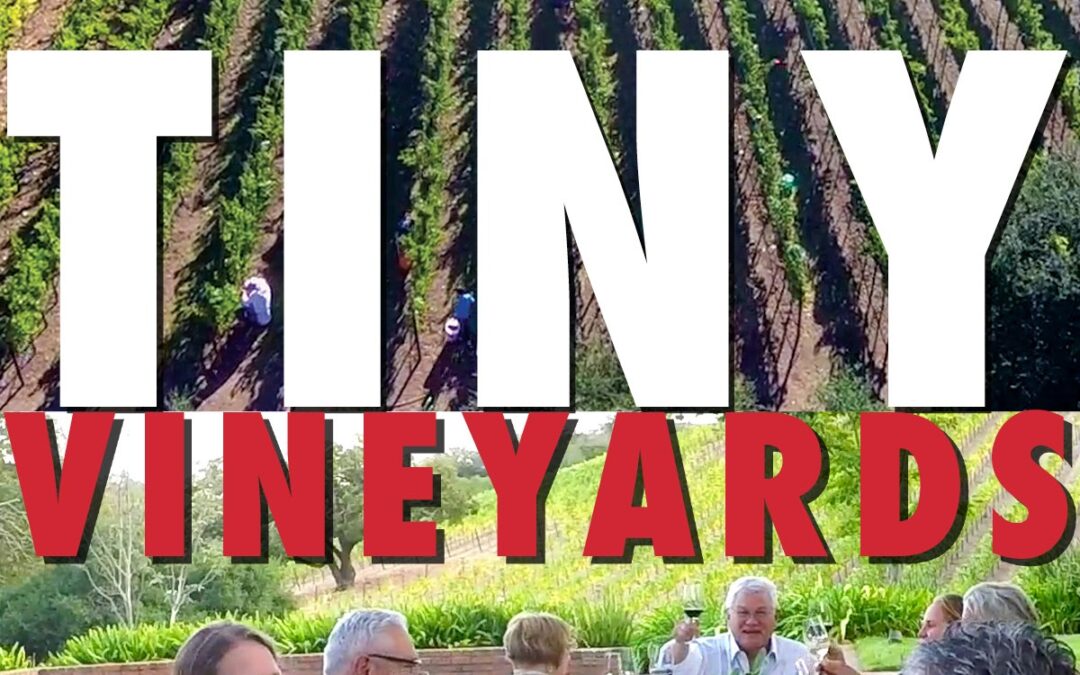
Mar 16, 2019 | Wine
Very excited to make this ‘world premier’ announcement…for almost a year, famed documentary filmmaker Joe Daniel followed over a dozen Sonoma hobby grape growers and home winemakers through the 2018 season. The resulting film “Tiny Vineyards” is premiering at the Sonoma International Film Festival on Saturday evening, March 30th at 7:30pm in Veterans Hall Theatre #I.
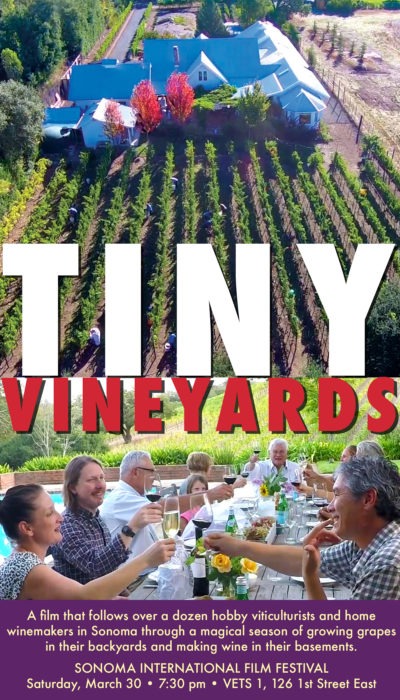
Several Hydeout Sonoma clients, as well as our home-ranch Dysfunctional Family Red Blend project, appear in the film. I have not yet seen the film – but the process of being followed around day and night with microphones and cameras and drones was harder and more disconcerting than I ever expected.
Everyone is warmly invited to join us for the premier. And we’ll be tasting many of the local Sonoma wines featured in the film immediately after the screening, including our “Dysfunctional Family” Red Blend 2016.
Please scroll down for ticket ordering instructions. Apologies in advance – it looks like the on-line system for the premier Saturday screening might already be sold out. The festival office may re-open ticket sales, or schedule a second screening time. Please check back on-line regularly to see if tickets are available or if a second screening has been scheduled. And get in line early for a good seat.
One of the hobby winemakers…
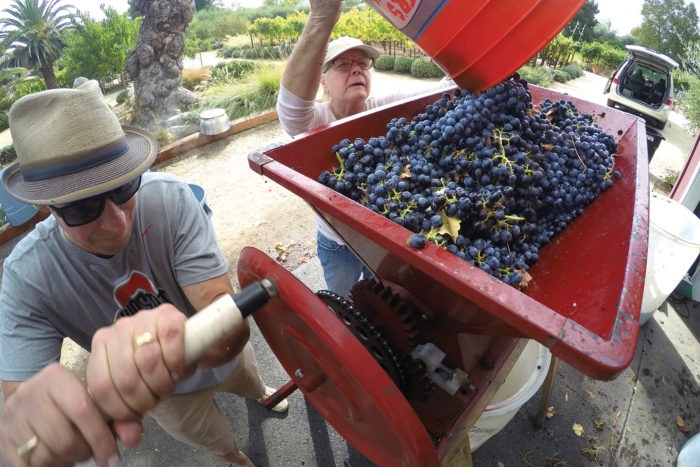
Purchase Movie Tickets:
- Click on this link: http://www.sonomafilmfest.org/film-festival-guide.html
- Select purple “film guide” (not “schedule”)
- In the search bar, type the word “Tiny”
- Below the search bar should appear the “Tiny Vineyards” image, click on the image
- Then choose “select a showing’ (on the right side in purple)
- Then choose the date option – Sat March 30th
- Then click on “order tickets”
- A “checkout” screen will appear that will allow you to select the number of tickets
- Then enter your email address and hit ‘continue’
- You will continue with the checkout process – by entering your name and desired password.
- Then, enter payment information (credit card info , etc)
- Then, click on the purple ‘submit payment information’ button
- Then, click on the purple “buy” button
If you’ve done it right, this screen should appear.
Then, you’ll receive an email – with a PDF at the very bottom.
Click on the PDF and each purchased ticket will be viewable with a unique bar code on a separate page.
Another Sagrantino vintage:
This will be the fourth ‘leaf’ and the first full harvest of our Sagrantino grapes. Of the tiny 2000 acres of Sagrantino in the world, their are less than 15 in the United States. But it is a variety very much worthy of attention -especially for red wine lovers that enjoy cellar aging their wines until they form amazing perfumed aromas. Here, the vineyard floor has been freshly mowed to warm up the soil, and we are about to start pruning the vines:
In other winemaking news:
Winter is over and with it malo-lactic fermentation (often called ‘secondary fermentation’) has completed for some of our client’s 2018 red wines. Those wines, which have been resting in barrels, need to be “racked and returned” – meaning the clean wine is removed from the barrels into a tank, the normal sediment is cleaned from the bottom of the barrels, and then the clean wine is returned to the barrels to age for many more months and years. This process takes a couple of days as every barrel is carefully scrutinized and tasted and lab analysis is conducted. Here we’ve pulled some of the barrels down from the warehouse onto the crush pad floor, and the tanks in the back have been sanitized, as we get ready for ‘racking’:
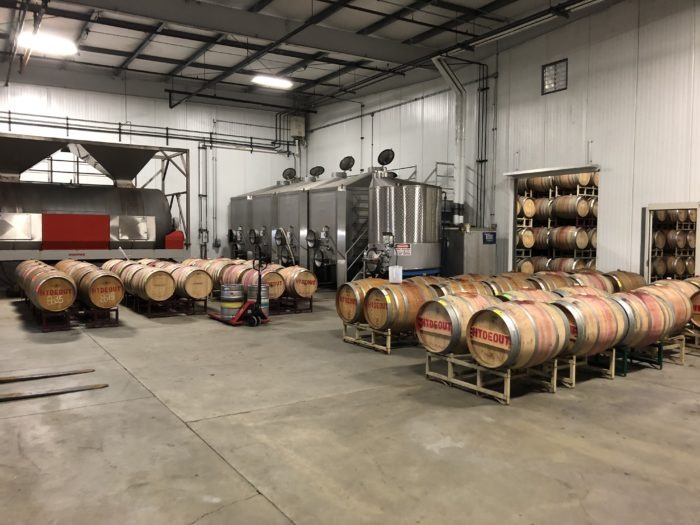
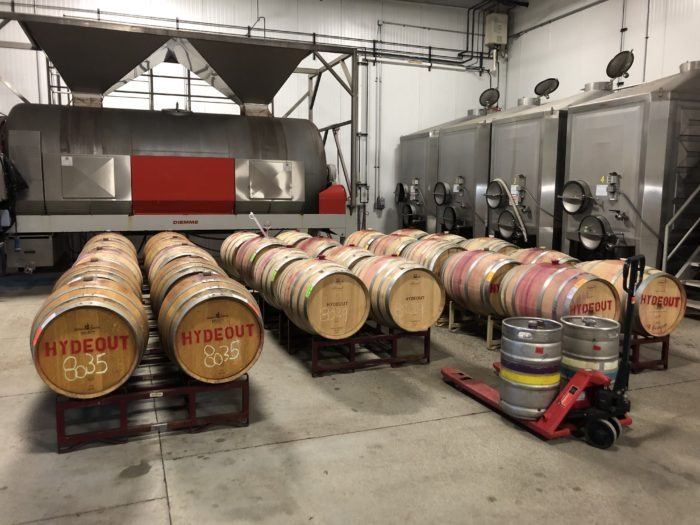
Generally speaking, after primary sugar-to-alcohol fermentation is complete (Sugar + Yeast = Alcohol + CO2 + Heat), oxygen becomes the enemy of wine. It is best to minimize the wine’s exposure to oxygen by minimizing handling, moving, pumping, and so on. Excess exposure to oxygen, and the resulting “VA” (known as volatile acidity or vinegar!) must be closely monitored. Some winemakers consider a tiny fraction of VA to add spice and interest, others take great care to minimize it. Either way, here is a brief video of the lab enologist starting the ‘VA through distillation’ process:
Hope to see you at the “Tiny Vineyards” premier.
Warmly – Ken Wornick, Hydeout Sonoma
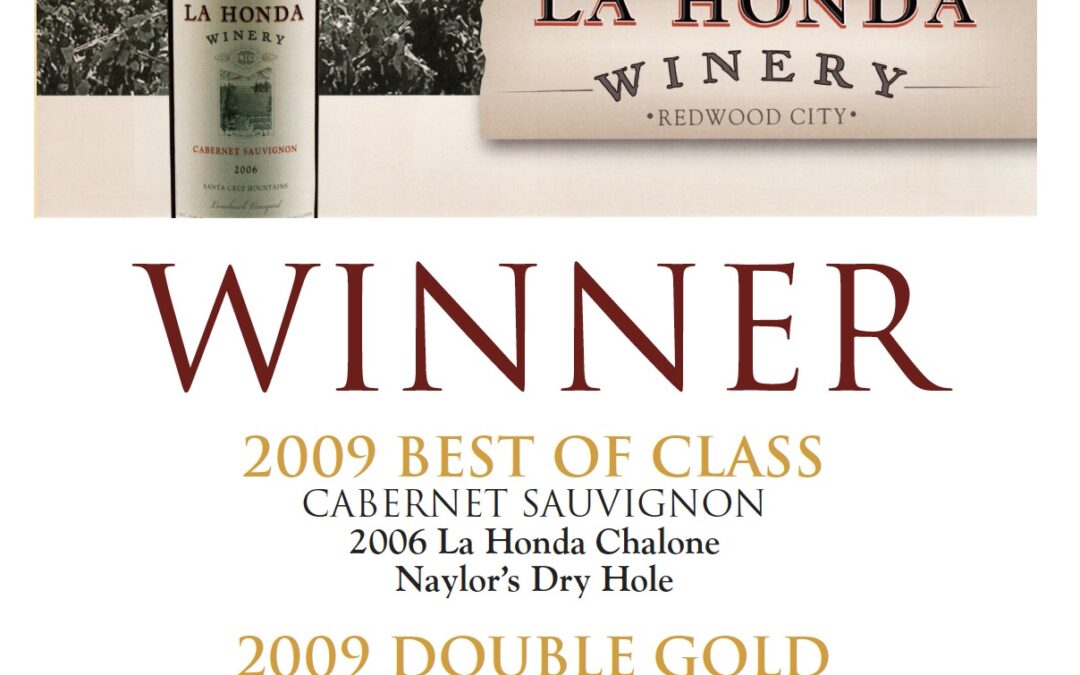
Feb 3, 2019 | Wine
As I happily enter my 20th wine vintage (1999-2019), please join me for a quick look back…
What started in 1999 as a small vineyard development company (Post and Trellis Vineyards in Burlingame, Ca.) grew in 2003 to include a winery (La Honda Winery in Redwood City, Ca.), and eventually in 2006 our branded wines which were distributed throughout the Bay Area.
This was the original team. That’s me in the cowboy hat, foreman Salvador in the green T-shirt, and asst. winemaker Colin in black sweatshirt and white ball cap. Quick back story – I was looking for an assistant winemaker to help me with the growing winery workload. I passed on many candidates – until I received an email from Costa Rica, from an American dude who was on a surfing safari. Winner winner chicken dinner; Colin took the job and is still at La Honda today, now making great wines as Head Winemaker:
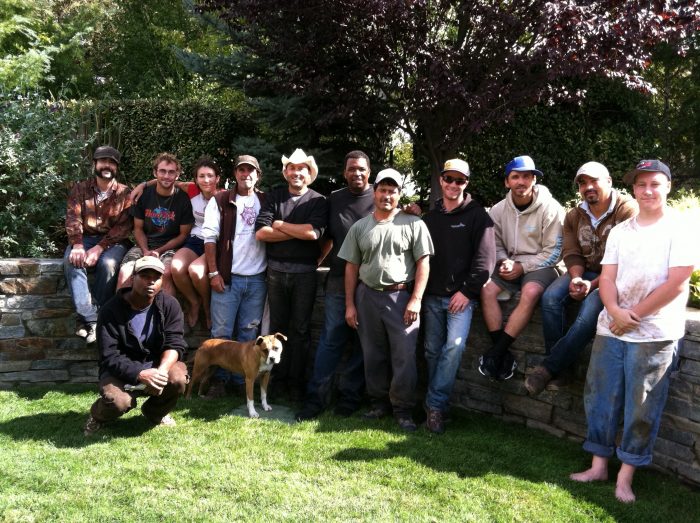
Here is the start to one of the earliest vineyards we developed in Woodside, San Mateo County. In those days, we marked out the vineyard old-school style – with string and stakes. And then used a bobcat to drill the holes for the end posts:
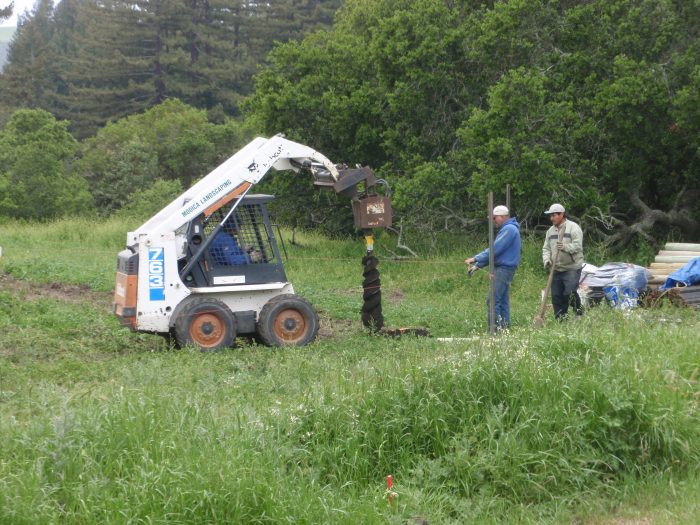
This is Cabernet fruit from one of the first harvests:
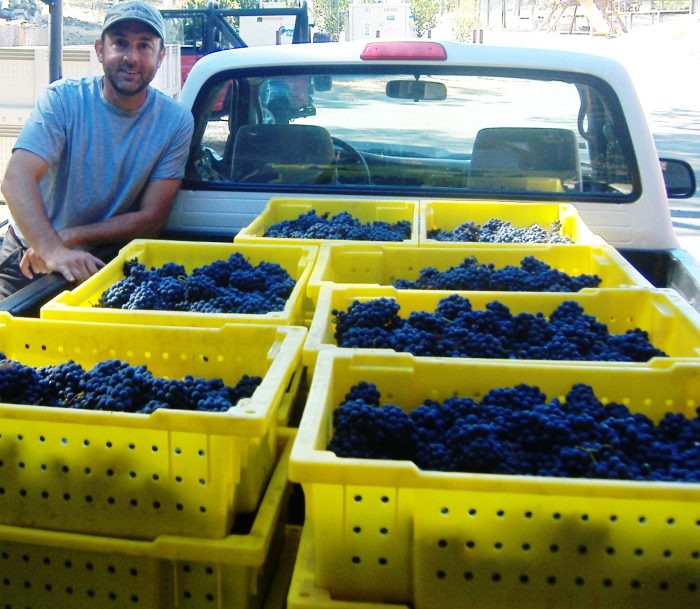
When we passed the dozen-vineyard-clients mark, we got up the courage to start building out this custom crush winery for our client’s fruit, in Redwood City:
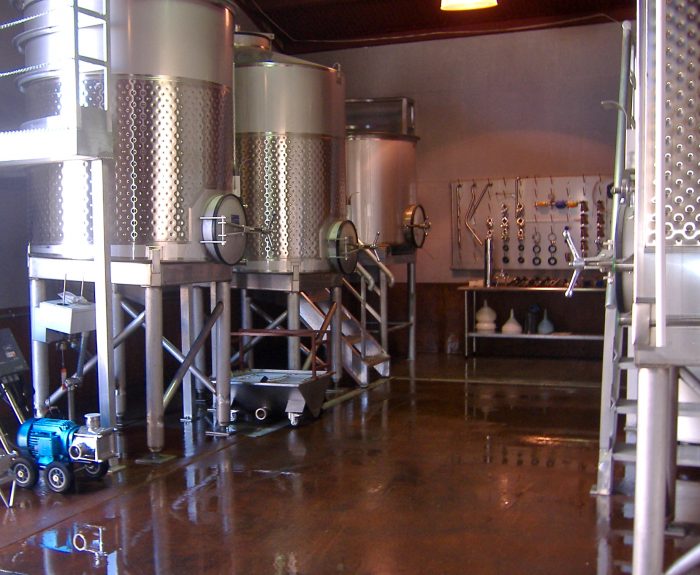
And we employed our kids and their friends to help. Here are high school freshmen Dennis Wornick and Nicholas Martin stomping on fruit:
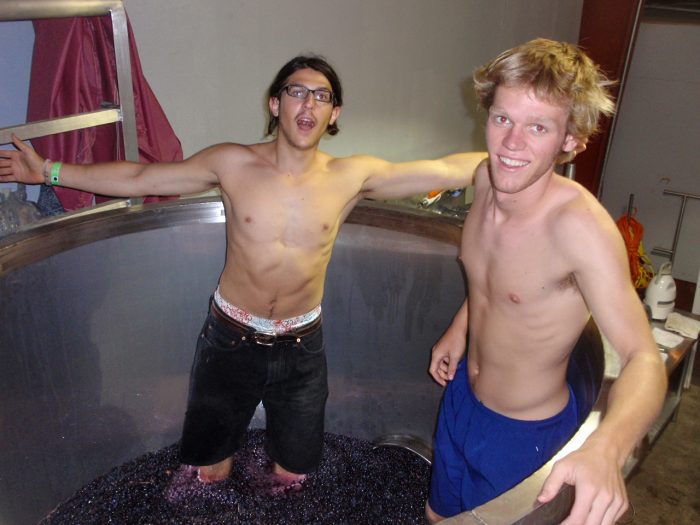
This was the very first bottling run, looks like Chardonnay, all done by hand one bottle at a time, but assisted by many terrific friends:
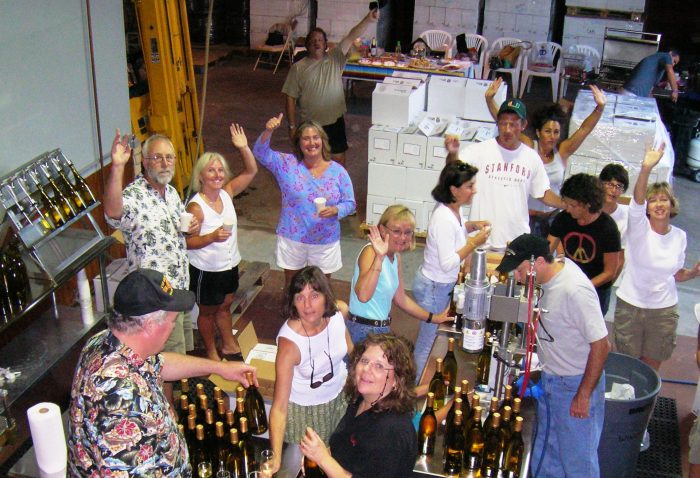
It wasn’t long before we opened the winery to the public. And because we were one of the first ‘urban wineries’ on the SF Peninsula, the crowds grew pretty quickly. We enjoyed major events with visitors from overseas, and many local tech companies like Apple and Google held their corporate events at La Honda:
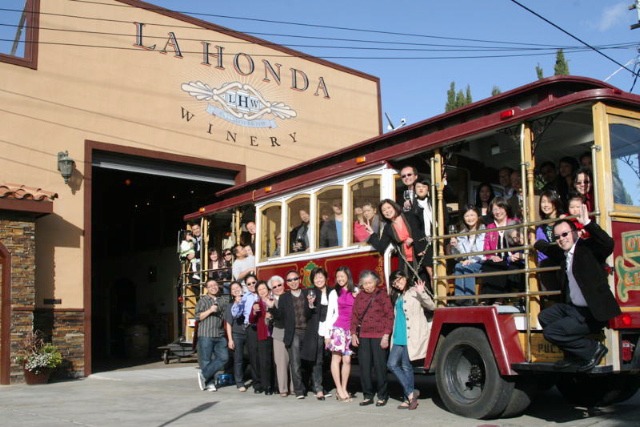
Our motto then was “think globally, drink locally” and we thought ourselves pretty sharp with no help on that tag line from a PR or advertising agency!
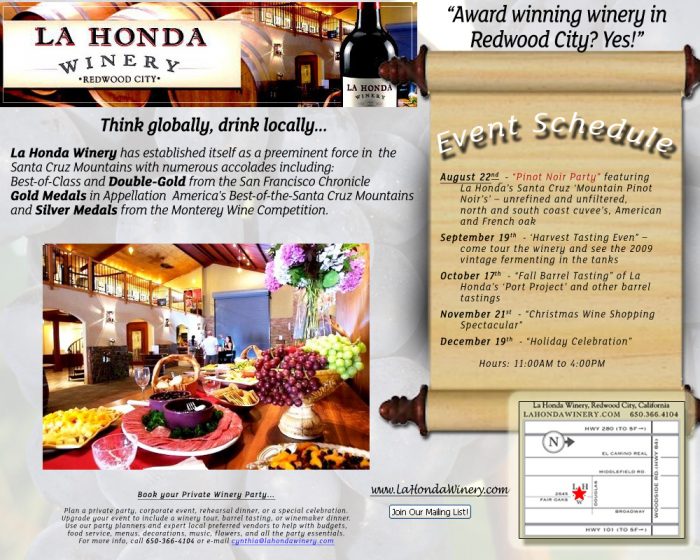
By 2006, we were farming more than 40 vineyards between San Francisco and San Jose. Placed on top of a geological map, you can see the soil types and varieties for each location:
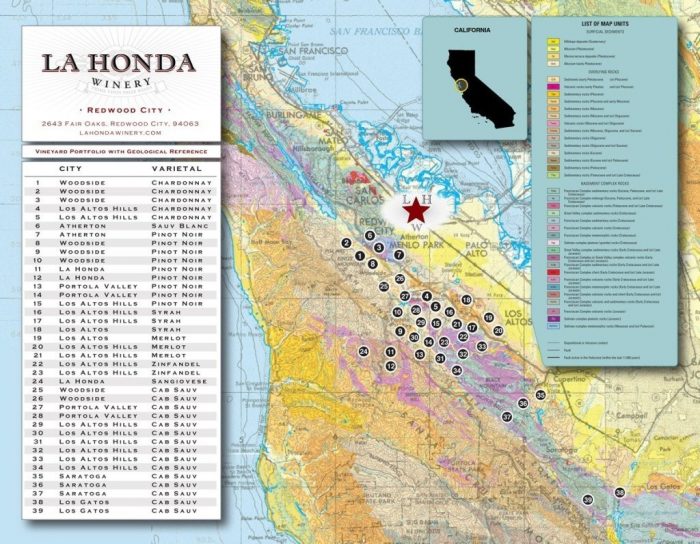
And our wines began winning awards – in 2009, we received ‘Best of Class’ and ‘Double Gold’ from the San Francisco Wine Competition, and 93 points from the Wine Enthusiast:
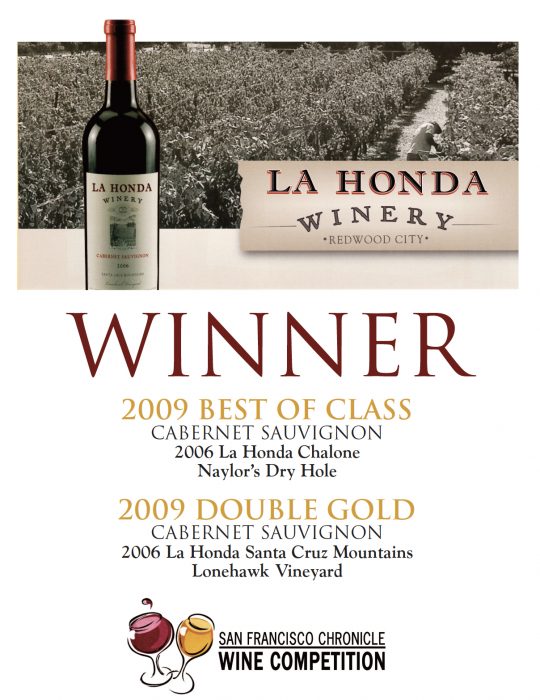
After 14 years building vineyards and making wine for our clients in the Bay Area, we sold Post & Trellis Vineyards and La Honda Winery to a private investor. And moved to Sonoma to start the process all over again. Now under the name “Hydeout Sonoma”, as we enter our 20th year in the industry, we are working with over a dozen wonderful clients, and soon introducing many new brands. The map below shows some of our vineyard locations from Sonoma to Napa:
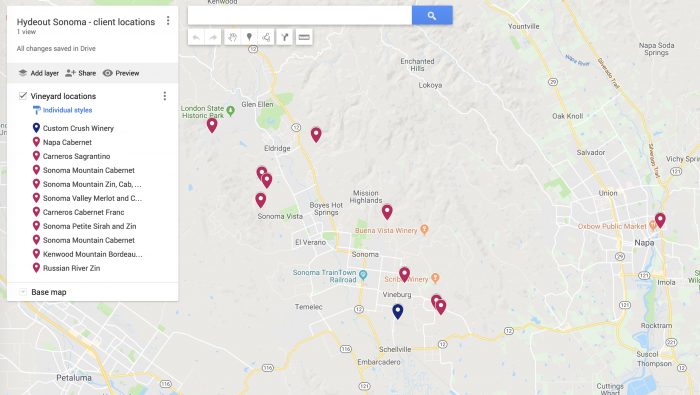
Here, a client is celebrating their very first harvest, about 5 tons of Sonoma hillside Cabernet:
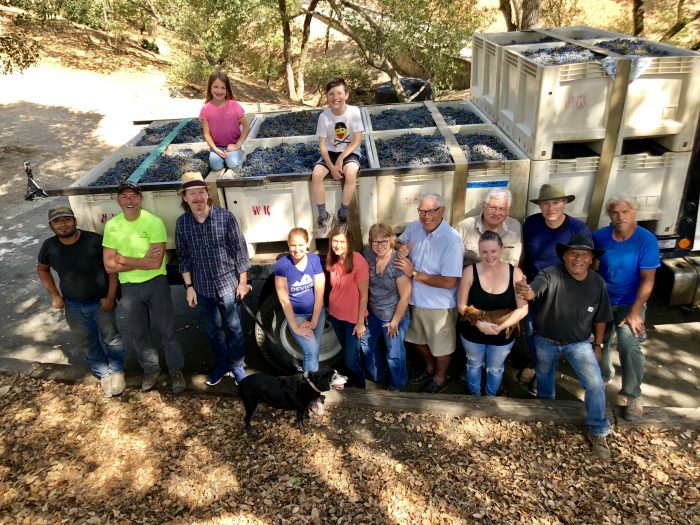
In 2018, many of Hydeout Sonoma’s client wines rest comfortably in barrels:
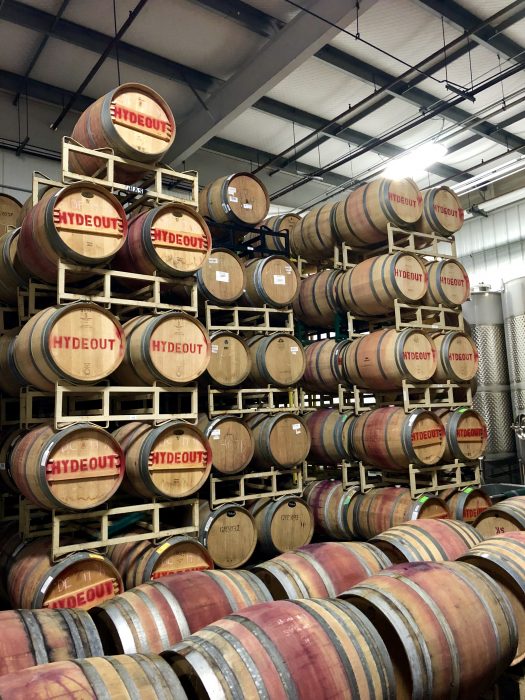
Thanks for taking the trip down memory lane!
Our current project is to get the Use Permit from Sonoma County for our new Dysfunctional Family Winery Hyde Road. And we look forward to many more years of grape growing and winemaking.
Thanks for being a loyal reader of Hydeout Sonoma’s blog.
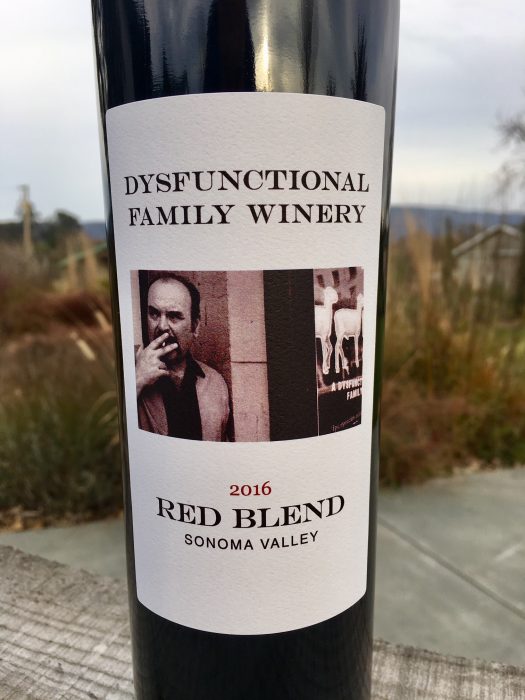
Next report: a first hand visit to the wines of Patagonia…by motorcycle.
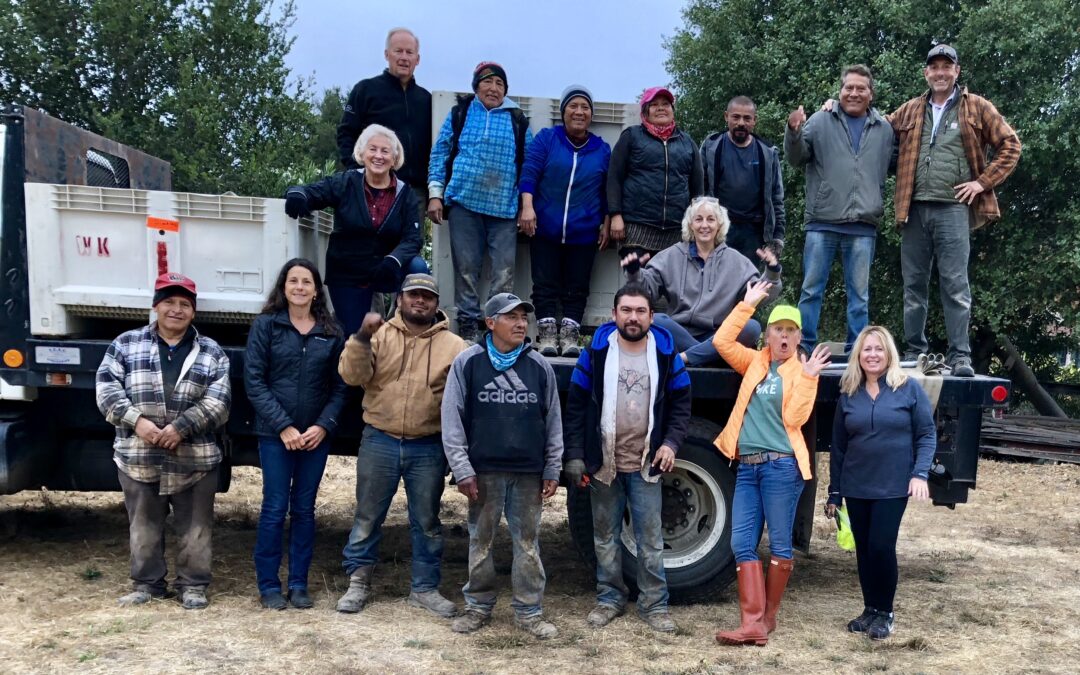
Oct 14, 2018 | Wine
Sonoma Harvest, Part 1, “The Night” featured some harvests at night. As the sun rose and fruit was loaded onto the trucks, here are some daytime images of a few of our client’s harvests. And check out the winery videos and fermentation chemistry at the end. In all of the stories below, Hydeout Sonoma is responsible for all vineyard farming, winemaking, and the brand identities of these hand-made boutique wines…
Featuring an incredibly lovely and fun couple from New York, and their very authentic Italian patriarch, Pasquale, (bottom row, second from left), these clients celebrated their 3rd harvest of mountain-terraced “field blended” Cabernet, Sangiovese, and Zinfandel. This fruit was harvested in the early morning hours and rushed to the winery to be turned into a singular ‘estate’ wine. Available for sale in 2019!
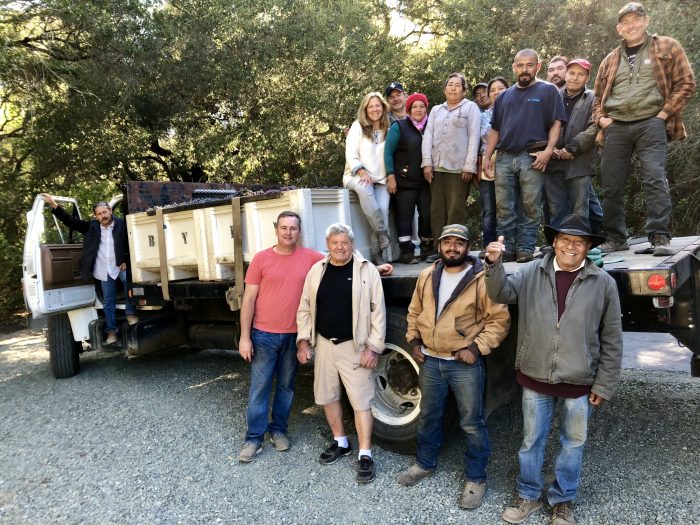
Hailing from San Francisco, with children, aunts, and uncles all pitching in, this new client recently acquired their steep 100% hillside Sonoma Mountain Cabernet vineyard (which we have been farming for three years for the prior owner). As you can see from the white 1/2 ton bins, this vineyard yields spectacular dense fruit that delivers a classic Sonoma Cabernet. Inky, full of dark fruit, and soft silky tannins. Available for sale in 2020!
 \
\
This very creative son-and-matriarch team (middle of bottom row) from the island of Hawaii standing in front of their harvest of 12-year old Napa Cabernet from their ranch near Monticello Road This harvest produced a yield of almost 5 tons of deep dark inky opulence. The fruit will make a highly-customized Napa Cab. Available for sale in 2020.
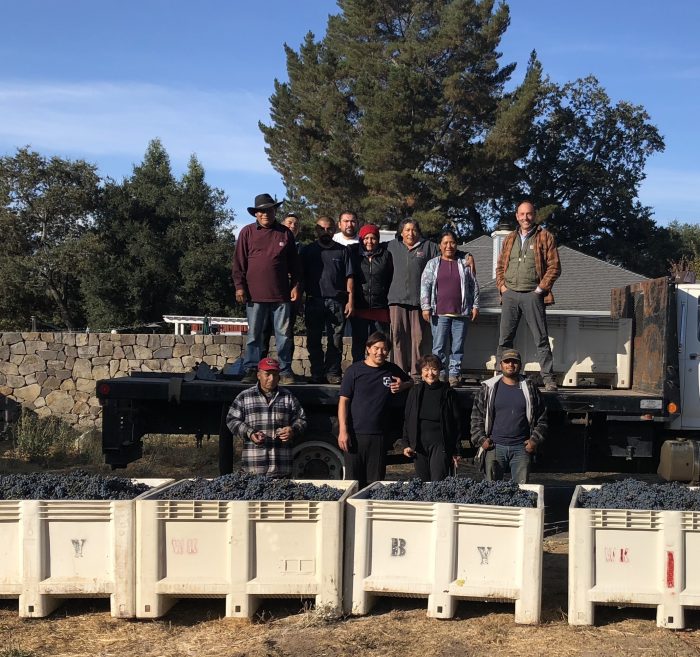
And this rag-tag crew of wonderful family, friends, and the Hydeout Sonoma farming team (plus a special shout-out to the Kansas City-based picking crew!) helped harvest the very 1st vintage of Hydeout Sonoma’s “Sagrantino” (from our 11-acre Carneros ranch, a 100% Umbrian red varietal) and also the 2nd vintage of our Dysfunctional Family Winery “Red Blend.” Dysfunctional Family will be available for sale in 2019. And the “yet-to-be-named” Sagrantino will available in 2020.
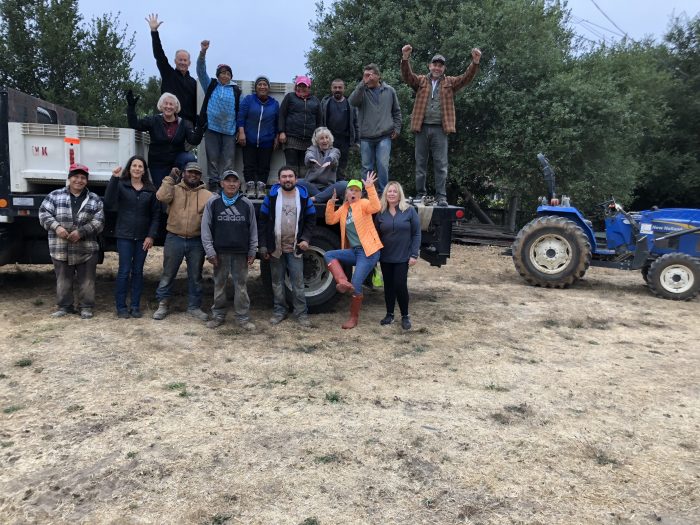
These good fellows (client, father-in-law, and uncle) worked very hard to help us harvest their family’s Cabernet grapes starting at 6:30 in the morning, then followed us to the winery to observe the fruit being meticulously processed. And then they hustled back to cook a spectacular steak-and-potato harvest dinner. When I arrived, the sun had already set, but the corks of these four special wines were just being pulled and generously shared!
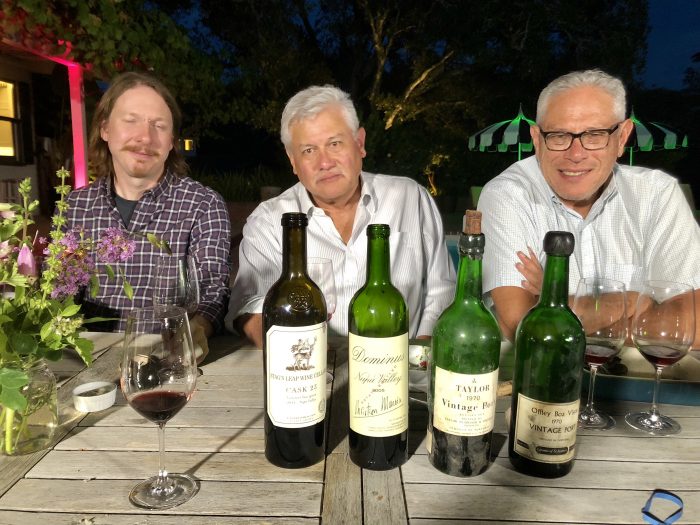
My loyal and true partner through the entire farming season and harvest, Señor Tacho Enriquez, carefully looks after our people and farm equipment. Here he is being supervised by our “Buho Jefe”, Hydeout’s pet owl. This plastic owl is supposed to keep birds out of the vineyard. It doesn’t. But it’s fun to have around.
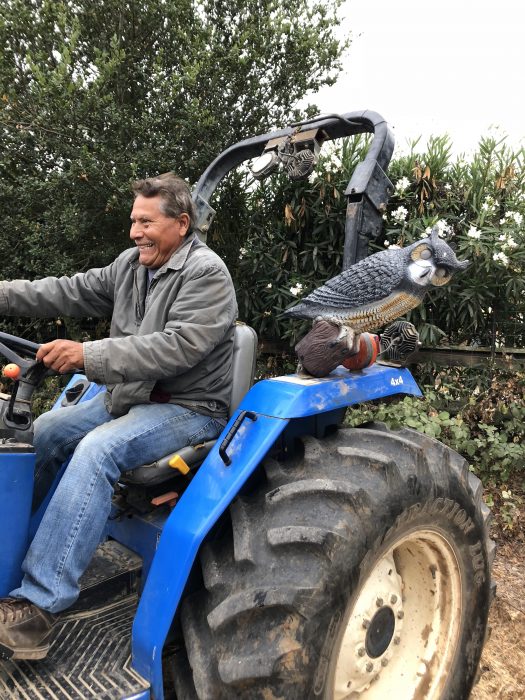
A brief visit to the winery…
Once the fruit is fermenting, it’s time for pump-overs and punch downs. After the fruit is destemmed, moved into the fermentation tanks, cold soaked, and finally inoculated with yeast, the grape skins start to rise to the top of the tank (see the organic chemistry note below for more info). Two to four times per day, every day, we pull the juice from the bottom of the tank and ‘pump it over’ the top – this pushes the grape skins back down into the liquid must (see the white hose coming from the lower part of the tank, into a pump, then up the stairs to the top). In smaller tanks, this is done from the top by manually pushing down on the skins, and is called a ‘punch down’. As the skins are forced down into the liquid, and as alcohol slowly accumulates, the alcohol acts a ‘solvent’ soaking the polyphenols (tannins, flavonoids, color, and body, etc) from the skins into the wine. Managing this process carefully is part of what makes a good wine great.
Start with great fruit…
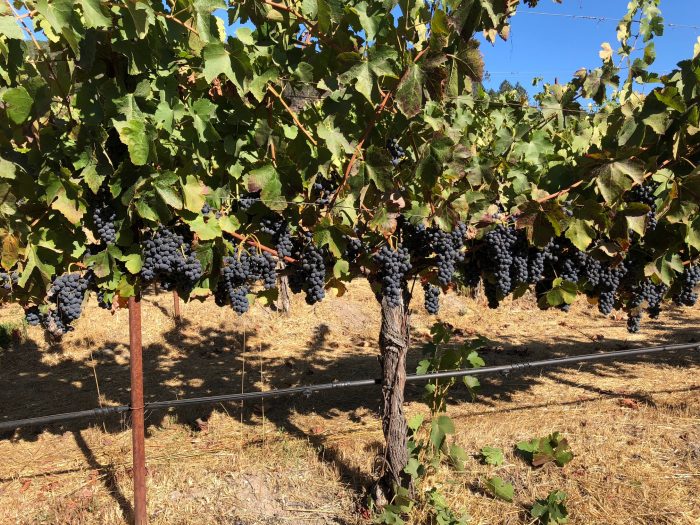
Get it quickly to the winery crush pad…
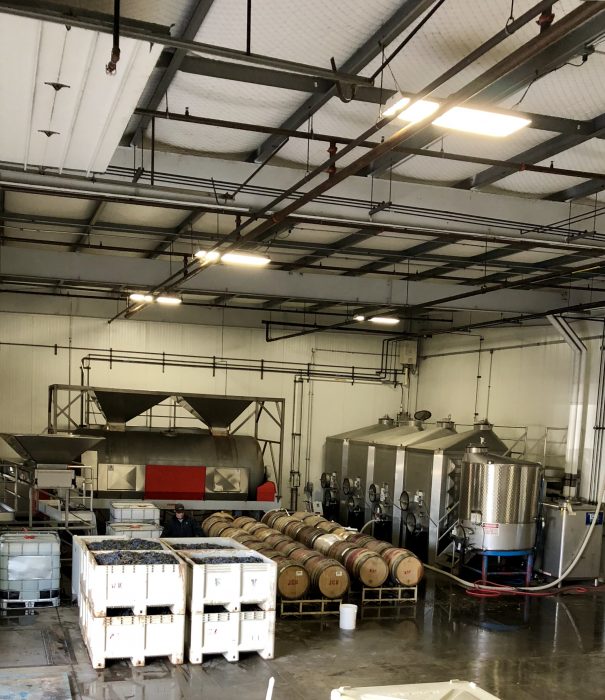
Ferment it to perfection…
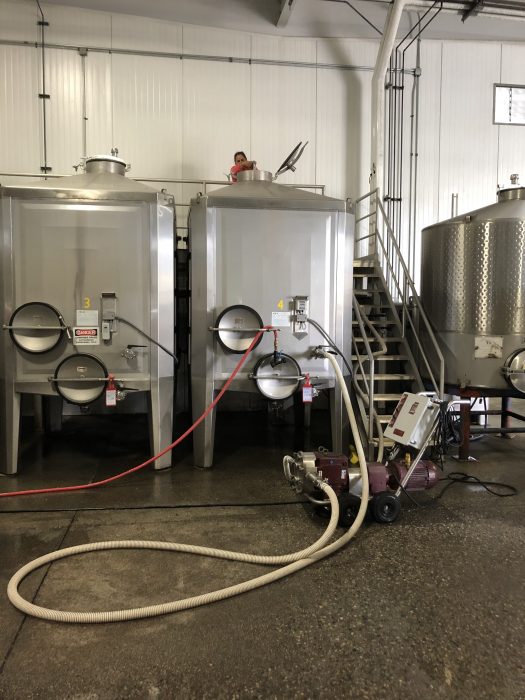
Transfer the almost finished wine into barrels for aging, then wait a year…
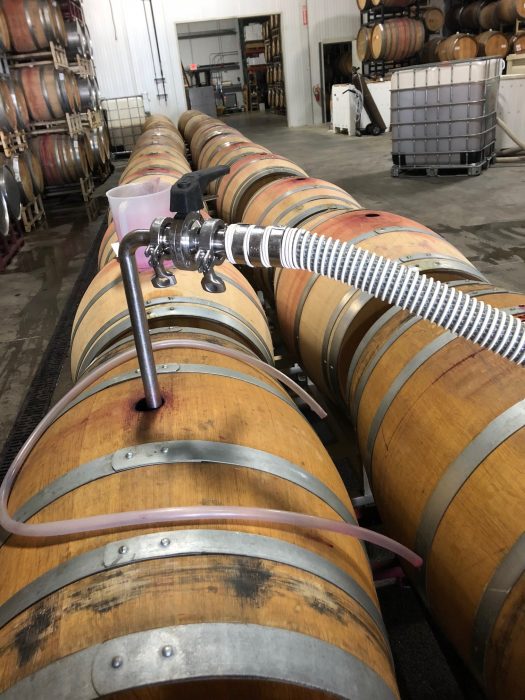
Brief videos of a few winery processes:
video: stems being removed from the grape bunches
video: small tank hand punch down
video: 1000 gallons of wine being pumped over
Note: Yeast will convert sugar into alcohol at a ratio of approx 62%, the remaining 38% of the equation becomes CO2 and heat. The heat and CO2, in gaseous form, rises in the tank taking the grape skins with it. Thus the need to ‘pump over’ or ‘punch down’ the skins back into the fermenting juice.
Glucose is first converted to pyruvate by glycolysis, and the pyruvate is converted to ethanol and CO2CO2 in a two step process:

For the second step function, start with pyruvate, for alcoholic fermentation the net reaction is:
Glucose+2ADP+2Pi+2H+⟶2CO2+2C2H5OH+2ATP+2H2O
And here is a general flow chart of the red wine making process:
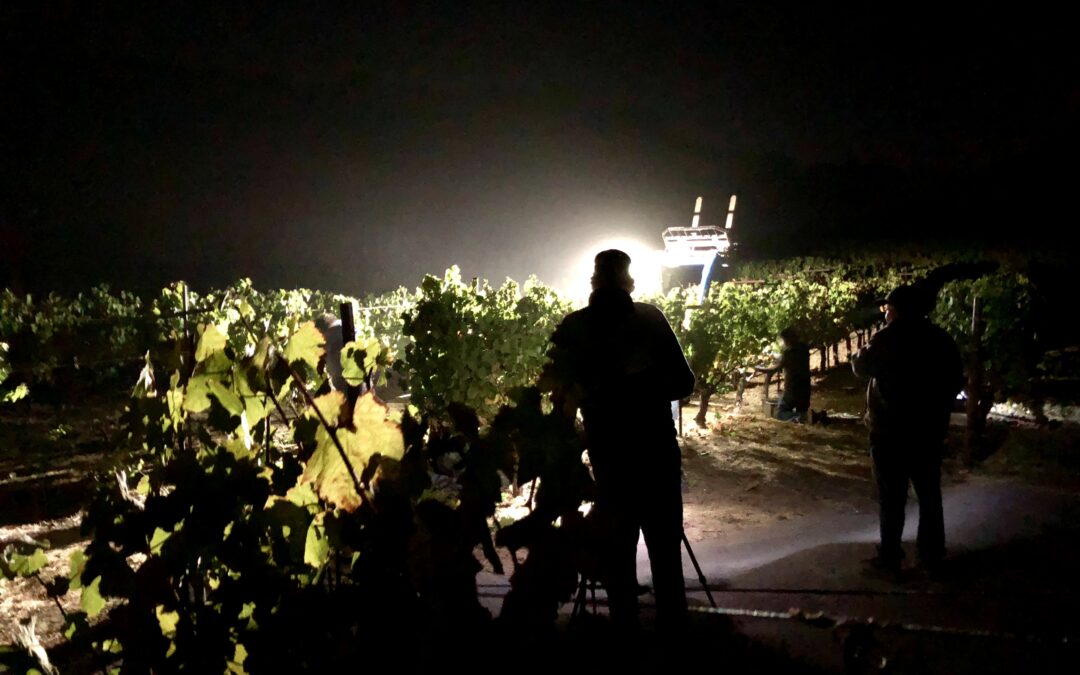
Sep 30, 2018 | Sonoma, Vineyard, Wine
Here is your Sunday Morning just before brunch wine podcast. While you were sleeping, Sonoma Valley was hard at work harvesting wine grapes at night.
You might ask, “hey Ken, what’s it like to prepare for a night harvest?” I’ll tell you…Are the grapes ready?, where is that lab report?, where are the lugs and bins?, get the tractor over here asap, tell Don Tacho to grab more diesel fuel, make sure we have the crew ready to go…oh no, the bin trailer broke down!, get the welder on the phone, and how late is Sonoma Market open for burritos? These are some of the features of getting ready for the nighttime harvest…
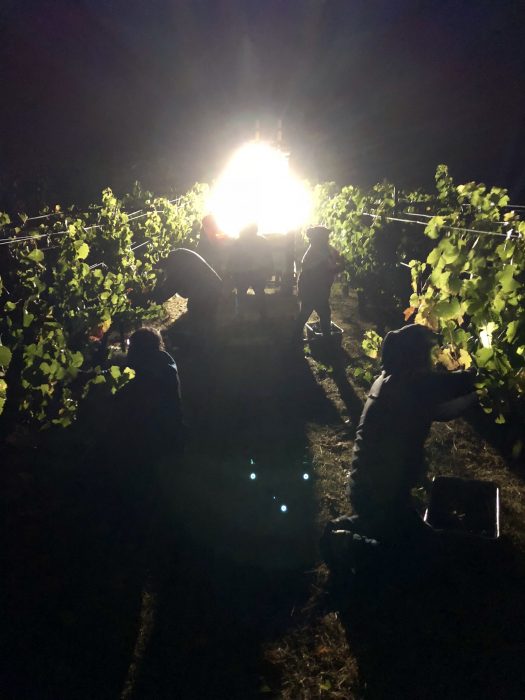
Do you love that cool-climate Pinot? Maybe that spicy Syrah or that dark inky GSM blend? To make these wines, the grapes must arrive at the winery very chilled. Warm grapes will begin to ferment almost immediately. Start picking at 7:00am, and the grapes will be 85 degrees by mid-afternoon. And that’s how bad flavors can arise – like vinegar (acetobacter) and nail polish (acetone). So picking at night assures the grapes will arrive at the winery in mint condition.
Many vineyards are too large to be picked in a few hours. So we must start a few hours after dusk in order to get all the grapes picked, loaded, and delivered by the early morning. Whether the vineyard is large or small, wineries (and winemakers, like me) prefer that fruit arrives at daybreak – so that we have the early morning to calmly process the fruit and move it into fermentation tanks. And then run the labs: brix (sugar), pH (logarithmic scale used to specify the acidity or basicity of an aqueous solution), TA (total acidity), etc.
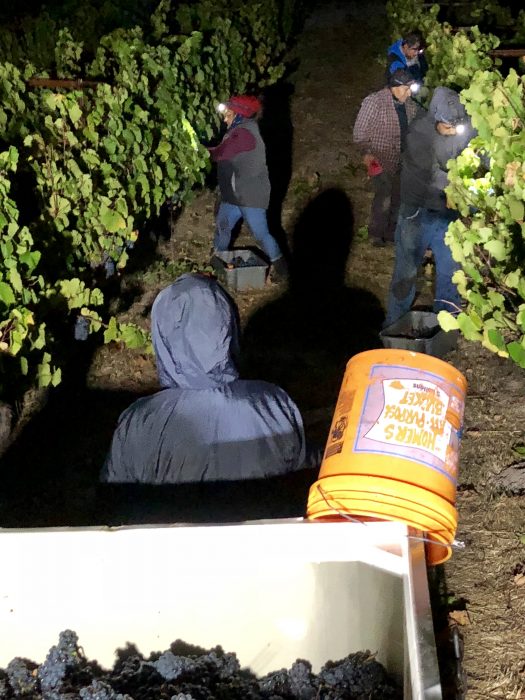
If you have not fallen back asleep yet, terrific. Here are a series of short (and hopefully dramatic) videos documenting one of our recent September 2018 night harvests:
Its a few hours after sunset, the cool fog has rolled in, and we are underway…
video: foggy harvest
Now it’s pitch-black outside, and picking continues using headlamps…
video: closeup of señora Marta picking
Heavy lugs filled with 40 pounds of hand-picked fruit are laboriously carried to the half-ton bins which are being towed behind the tractor lights…
video: two lugs delivered
Highly experienced grape picker Señor Claudio keeps his AM radio going to Oaxacan La Banda music all night long. Claudio has many loving nicknames, my favorite is “El Maquina” (the machine) mostly because rain or shine, hot or cold, he never ever wears a hat or jacket. Believe me, we have offered, begged, cajoled, but he insists…
video: Señor Claudio and his am radio
The tractor pulling the half-ton bins provides bright light in the work area. But it’s an odd sight when you step just a few away…
video: the weird world under the lights
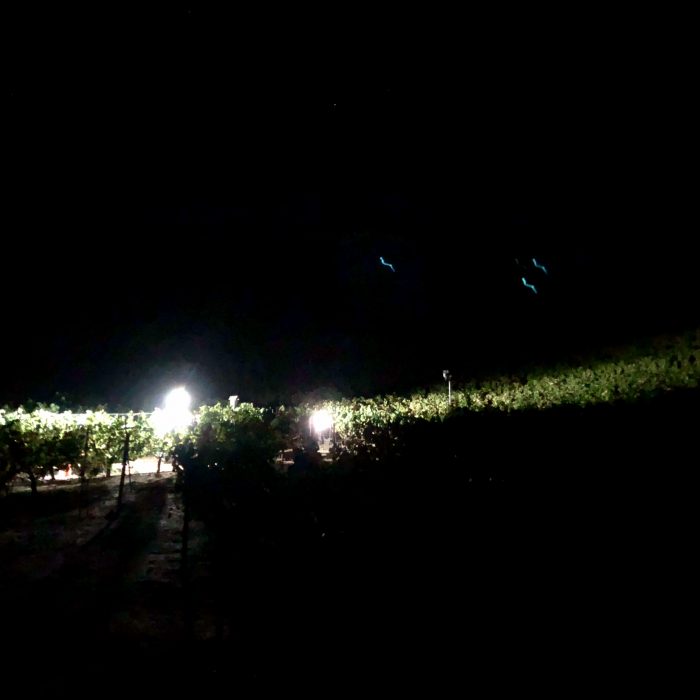
As the night fades away and the sun begins to rise, it’s time to count up the 1/2-ton bins and get staged to load onto the flatbed truck and get the fruit to the winery…
video: counting the bins at the end
And that’s how a night harvest goes!
Coming in the next blog post: Sonoma Harvest 2018 Part 2 “The Day”

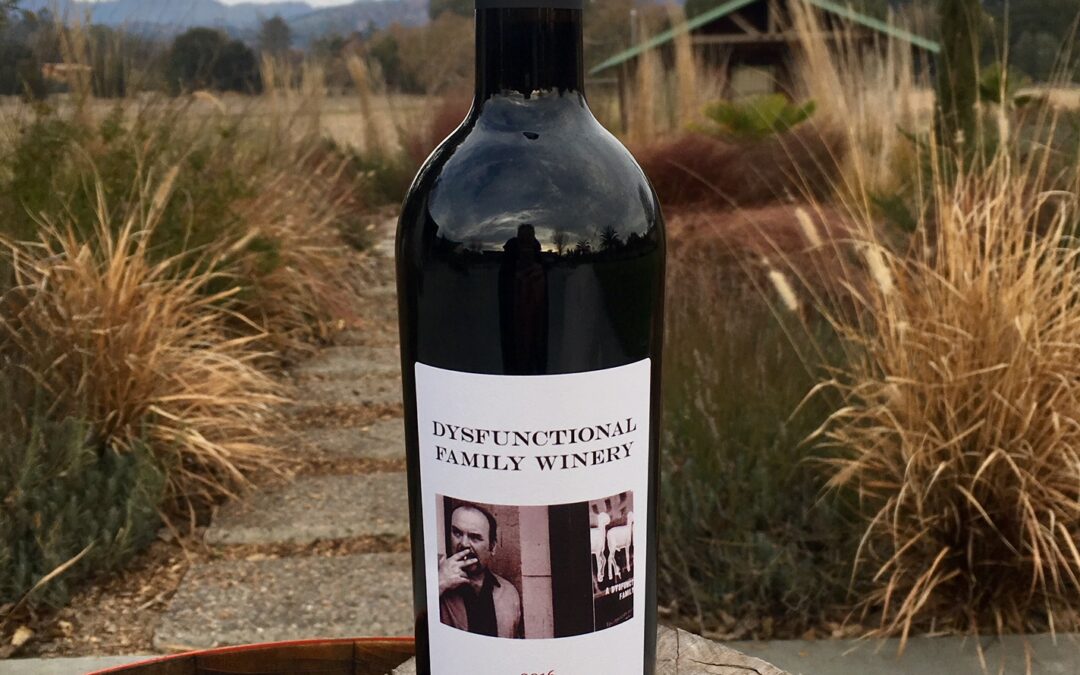
Sep 9, 2018 | Wine
On a gorgeous Sonoma evening, Dysfunctional Family Winery made its official and exceptionally grand public debut. The town mayor sang the star bangled banner (no, she did not). The Wine Spectator immediately awarded 100-points and declared it the ‘wine of the century’ (never gonna happen). And the Blue Angels did a super-sonic fly over (somewhere, but not here). Assisted by our rare and precious vineyard dog, Mr. Ploofy, (actually, we don’t have a dog) and our spectacularly gorgeous family (too ‘busy’ to attend), we proudly introduced our multi-generational (um, no) and outrageously expensive cult wine (hardly) to an adoring crowd (well, yeah, maybe).
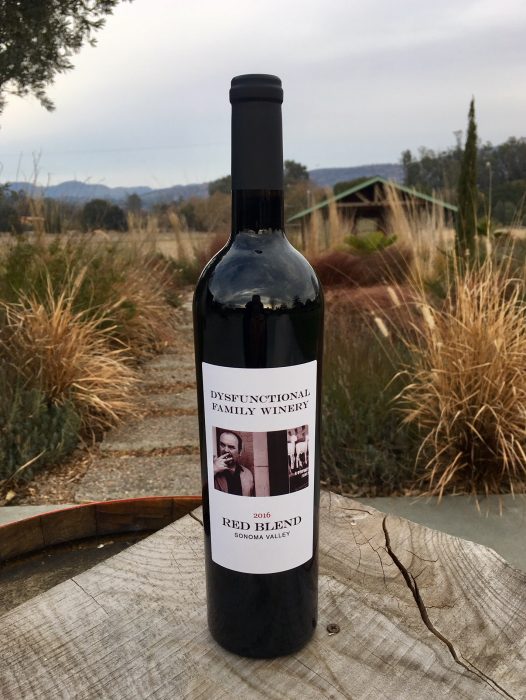
The occasion was the outdoor nighttime screening at Hydeout Sonoma of Martin Scorsese’s “The Last Waltz” (The Band, 1976).
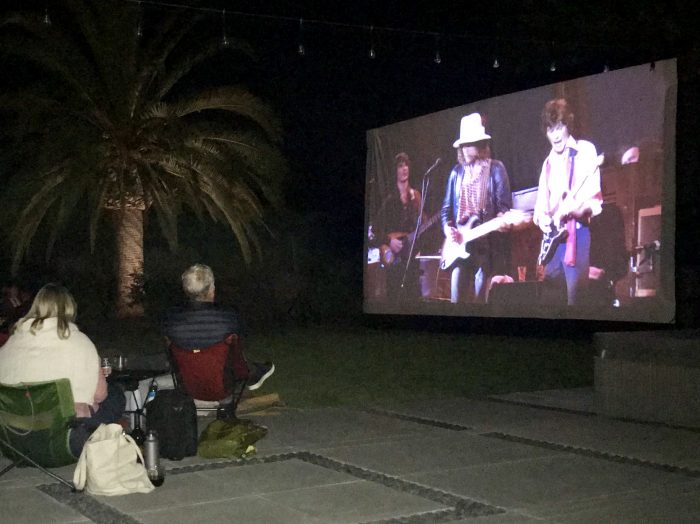
The venue was donated by me, Ken Wornick, (I am the winemaker) and the co-owner of the Hydeout, along with my immediate supervisor (otherwise known as my wife, Cynthia, who is on the board of the film festival). You can learn just how very fascinated we our with ourselves here:
https://www.hydeoutsonoma.com/about/
The event was presented by the Sonoma International Film Festival to a large crowd that spilled out over the lawn with chairs, blankets, and jackets. Everyone sang along (for real) with Bob Dylan, Robbie Robertson, Levon Helm, Neil Young, Emmylou Harris, Eric Clapton, and many others.
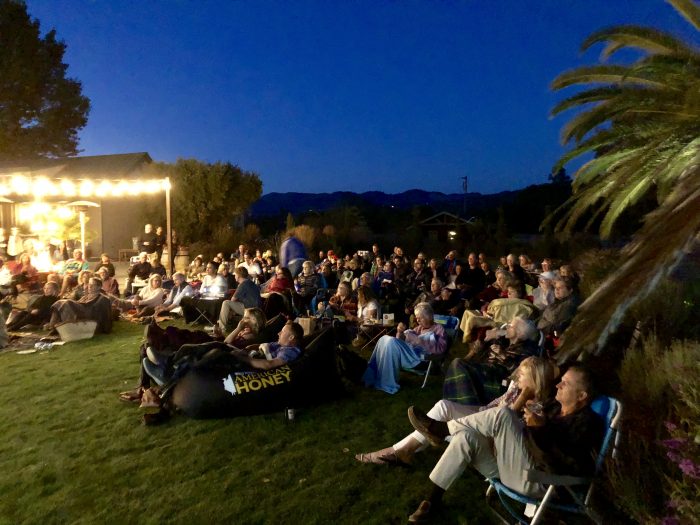
And everyone enjoyed many superb and well known wines from around Sonoma, each of whom generously support the film festival.
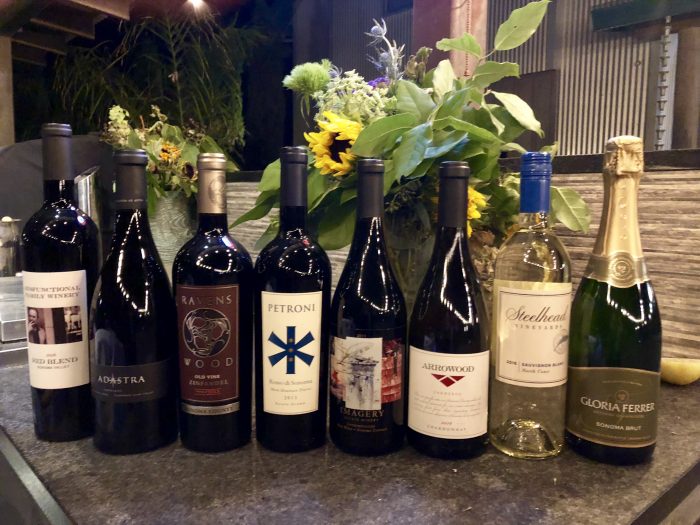
Executive Director of the film festival, Kevin McNeely, welcomed everyone, thanked the volunteers and hosts, chatted up the debut of the Dysfunctional Family Winery 2016 Red Blend, and introduced the film screening.
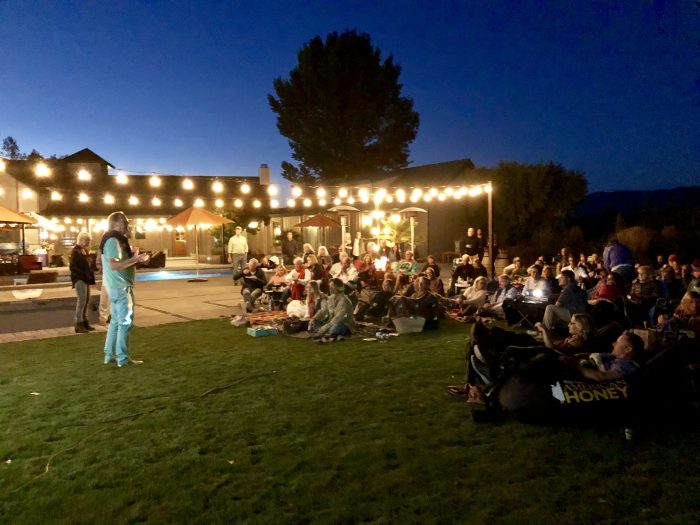
By the end of the evening, the night’s supply of Dysfunctional Family Winery 2016 Red Blend was exhausted.
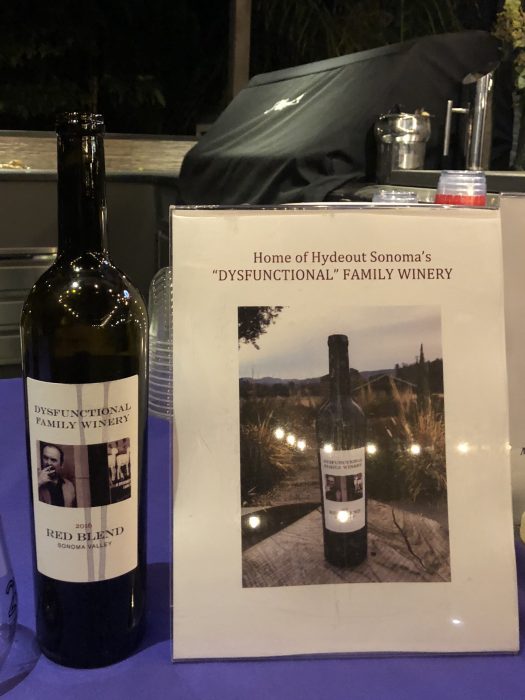
During the evening, wine and movie lovers enjoyed food from the well-known Sonoma food truck institution, El Coyote.
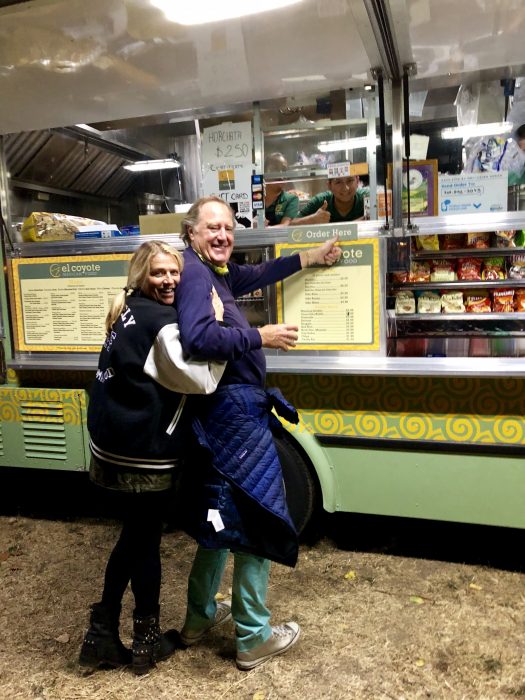
During a brief pause in the film, everyone dug into their tacos and burritos, and when the movie re-started, hoots and hollers were heard echoing across the lawn.
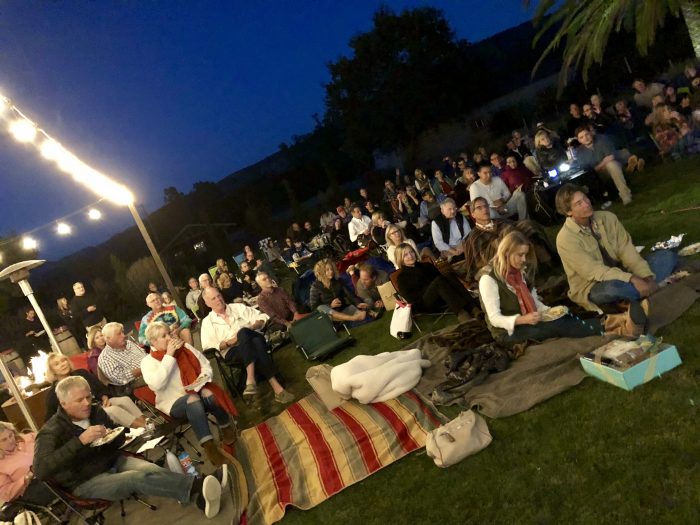
Another good time at the Hydeout. And a welcome start for the Dysfunctional Family Winery.

About the wine: Dysfunctional Family Winery’s 2016 “Red Blend” – Made of equal parts Cabernet Sauvignon (from Sonoma Mountain), Sangiovese (from Moon Mountain), Zinfandel (from Bennett Valley), and Merlot (from Carneros), the grapes were de-stemmed (but not crushed) and the whole berries were frozen-Nitrogen cold-soaked for three days, then fermentation was allowed to proceeded rapidly for 2 weeks, then the wine was pressed off fairly hard, and barreled up in a 50/50 mix of once-used French and American oak for 20 months; the wine is dark and inky, with a plush texture and evident fruit, but with soft tannins, and is meant to drink now. $25/bottle.
About the label: The photograph is an original shot circa 2006 by Dennis Wornick using a Kodak “FunSaver” instamatic camera, in the Tenderloin neighborhood of SF, and obtained this image of an actor walking outside from his theatre practice and captured standing in front of the ‘dysfunctional family’ window display.
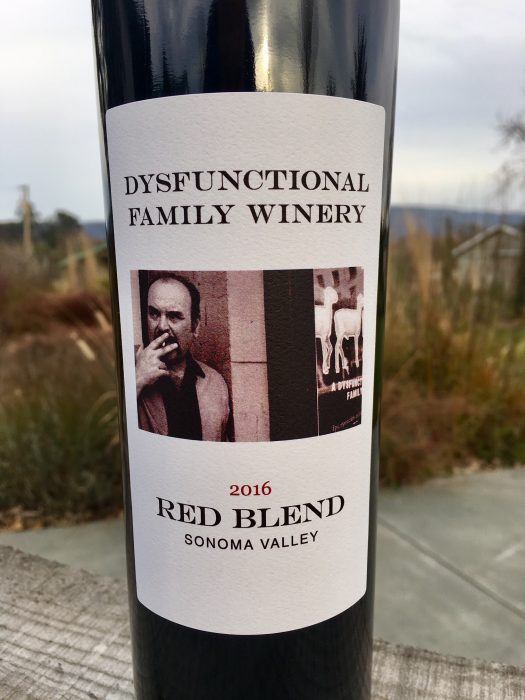
Links:
http://www.hydeoutsonoma.com
http://www.sonomafilmfest.org
https://www.yelp.com/biz/el-coyote-sonoma
https://www.youtube.com/watch?v=q2yW372qWH8
Please read closely: Dysfunctional Family wines are only available to the public at an off-site tasting room location (per Federal, State, Local, Deep State, State Department, and Bureau of Intensive Governent Meddling in Citizens Private Affairs laws, regulations, and don’t jump into the bathtub with an electrified toaster consumer protection statutes). We hope someday that this wine will be available for sale at the Hydeout (pending a permit currently under consideration at the Sonoma County Permit and Resource Management Department).
If you are interested in becoming a customer, please email us directly at kwornick@sprynet.com






